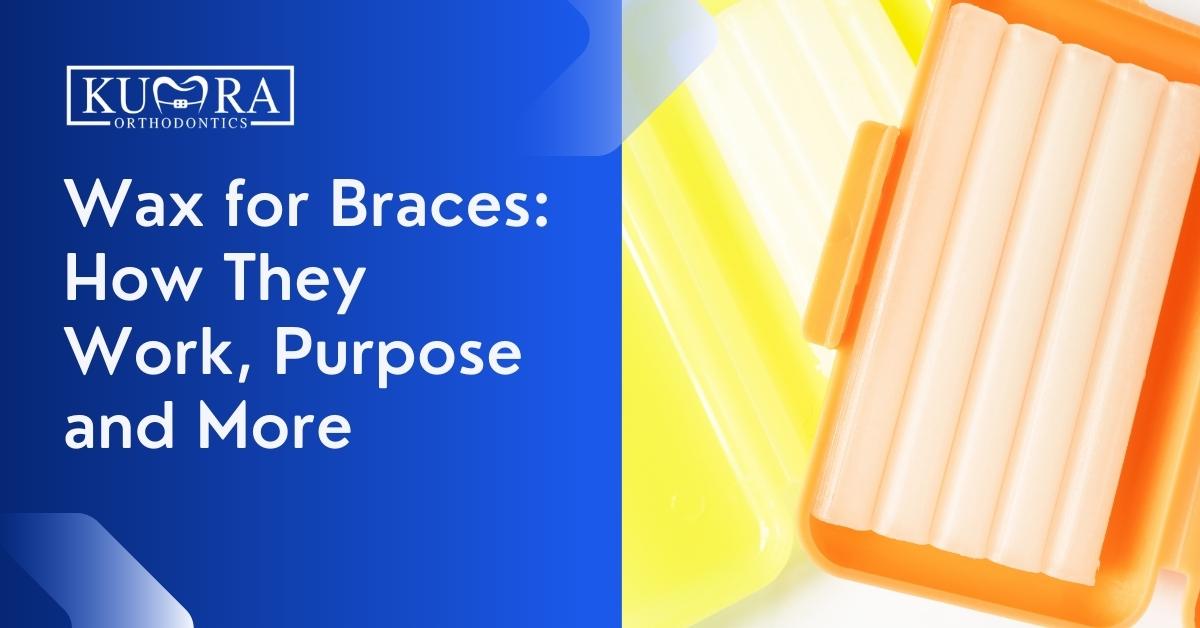Even though braces are a medical necessity, dental patients who have them know how bothersome they may be; for example, after having braces put on, you may notice a scratch on your teeth until you get used to the discomfort. In some cases, your braces may snap unexpectedly, leaving brackets and wires protruding from your mouth’s surface. This is when wax for braces comes into play.
How Does Dental Wax for Braces Work?
Dental wax makes them more comfortable and adaptable during the initial stage of your braces journey.
There are times when the brackets on your braces rub against the insides of your cheeks, or a bracket may come loose inside your mouth. This causes major discomfort. Covering the edge with the wax provides immediate relief.
Natural, non-toxic waxes are used in all orthodontic wax formulations. Carnauba or beeswax may be included in small amounts, and some may even have flavorings added. Most are paraffin-based and have no discernible flavor. Firm at room temperature but flexible when warmed by the human body. Small amounts of wax are entirely safe to consume.
Putting wax on your braces will separate them from your teeth. This solves mouth sores until you get to see your orthodontist, and these are easy to apply and remove, making them suitable for kids and adults.
Keep in mind that wax for braces is a band-aid solution until you get an appointment with your dentist. The treatment is not a cure-all for dental problems. To apply wax to braces, you can follow the manufacturer’s user handbook instructions. Call your orthodontist if you’re looking for more in-depth advice on how to apply wax to braces. You can also refer to the instructions provided below.
Needing an orthodontic appointment?
Visit Kumra Orthodontics Washington, DC or Kumra Orthodontics Stafford, VA, and request an appointment with us!
How to Apply Dental Wax
Because orthodontic wax is non-toxic and safe, you can apply it as frequently as necessary. You may even leave it on overnight if you believe it would assist in alleviating any discomfort or injury to the inside of your mouth while you sleep.
- Be sure to clean your teeth and wash your hands well before brushing your teeth. Bacterial infections will be prevented.
- Before applying braces wax, make sure your braces are completely dry. If a tissue is needed, do so.
- Locate the spots where the wires of your braces are piercing your cheeks and lips.
- Make a roll of wax out of a small amount. Warm the wax for at least five seconds. Rolls or balls in the shape of popcorn kernels are usually sufficient. Make sure you do not use too much wax.
- Place a little ball of wax on the spot that is causing you pain. Gently massage it in. Apply the wax to the brackets or cables that are causing you problems.
- Allow dental wax to work its magic for a while. And you’ll have a pain-free experience with braces. As you become used to your braces, you’ll notice that they’re less irritating and that you don’t need to apply wax as frequently.
Remember to have your orthodontist adjust your wire if it continues to protrude or become out of place. Dentist wax can be replenished at a pharmacy. Avoid damaging your braces or gums by using an interdental stick or floss.
When it comes to how long dental wax should remain in place, you can wear it overnight and replenish the wax as needed, but you should do it every two days. To eat and drink, you should remove wax if food gets stuck or the wax gets dirty.
Related: How to Cut Braces Wires at Home
Additional Tips
- If Q-Tip or tweezers fail to reattach dislodged braces, use orthodontic wax instead.
- Dentures can be waxed as well. Dentures are attached to your braces’ metal structure to keep them in place and stable. When the metal comes loose and irritates the inside of your mouth, dental wax can be a lifesaver in alleviating the pain.
- As with traditional braces, if you’re suffering any pain or discomfort while wearing clear aligners, you may benefit from applying dental wax. Apply the wax in the manner instructed above.
- If you’re having problems with your braces but don’t have any wax on hand, there are a few short-term fixes you may try. In the short term, you may find it helpful to apply a tiny bit of sugar-free chewing gum wrapped into a ball in the same manner as your regular wax. However, it would be best to remember that wax and chewing gum are not interchangeable.
- Dental wax can only be used for a short time. It needs to be replaced twice a day with a new one. If it’s falling off, replace it immediately. Keeping orthodontic wax in your mouth for longer than one day increases your chances of developing oral germs and cavities. As a result, food particles get trapped on the wax’s surface.
Purpose
Metal brackets and wires are part of the traditional orthodontic treatment. This wire is gradually tightened over time to exert pressure on the teeth and aid in their alignment. Brackets can irritate the mouth’s delicate tissues if they rub against them. Because they haven’t had time to adjust to the contact, the tongue and cheeks are particularly sensitive in the early stages. While you wait for these areas to harden, you can use orthodontic wax to protect your tongue, lips, and cheeks from abrasions by covering a troublesome bracket.
Read More: How to Take Care of Your Adult Orthodontic Braces?
Where to Buy Orthodontic Wax
Braces wax can be purchased online, at a drugstore, or straight from your orthodontics office. No matter where you get them, orthodontic wax strips are a reasonably low-cost item.
Contact Kumra Orthodontics to learn more about orthodontic wax for braces
Braces wax serves as a temporary measure to prevent additional harm. Visit your orthodontist as soon as possible for a long-term solution. Book an appointment today.



